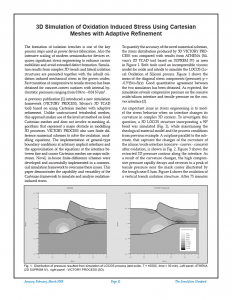3D Simulation of Oxidation Induced Stress Using Cartesian
Meshes with Adaptive Refinement
The formation of isolation trenches is one of the key process steps used in power device fabrication. Also the intensive scaling of modern semiconductor devices requires significant stress engineering to enhance carrier mobilities and avoid extended defect formation. Simulation results from complex 3D trench and lateral isolation structures are presented together with the inbuilt oxidation induced mechanical stress in the grown oxides. Fast transition of compressive to tensile stresses has been obtained for concave-convex surfaces with internal hydrostatic pressures ranging from 0.04 to –0.04 N/μm2 .
A previous publication [1] introduced a new simulation framework (VICTORY PROCESS, Silvaco’s 3D TCAD tool) based on using Cartesian meshes with adaptive refinement. Unlike unstructured tetrahedral meshes, this approach makes use of the level set method on fixed Cartesian meshes and does not involve re-meshing algorithms that represent a major obstacle in modelling 3D processes. VICTORY PROCESS also uses finite difference numerical schemes to solve the oxidation modelling equations. The implementation of general-type boundary conditions at arbitrary implicit interfaces and the approximation of the equations at the interface between fine and coarse Cartesian meshes are major milestones. Novel, in-house finite-difference schemes were developed and successfully implemented in a commercial simulation framework to overcome these issues. This paper demonstrates the capability and versatility of the Cartesian framework to simulate and analyze oxidation-induced stress.



